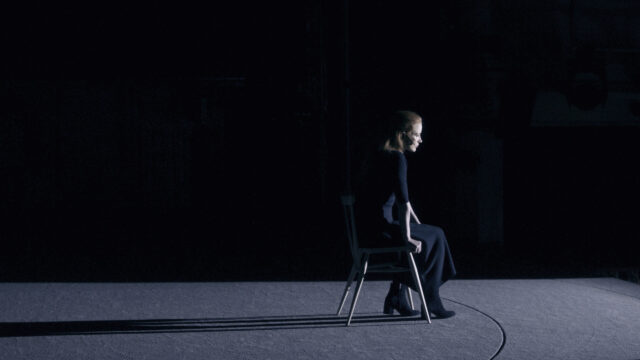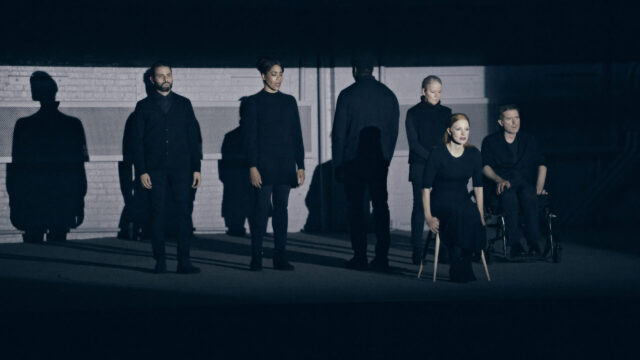
Jessica Chastain remains seated for most of A Doll’s House revival on Broadway (photo by Emilio Madrid)
A DOLL’S HOUSE
Hudson Theatre
141 West Forty-Fourth St. between Sixth & Seventh Aves.
Tuesday – Sunday through June 10, $70-$357
adollshousebroadway.com
www.thehudsonbroadway.com
The beginning and ending of Jamie Lloyd and Amy Herzog’s Broadway revival of Henrik Ibsen’s A Doll’s House at the Hudson Theatre are unforgettable, for significantly different reasons. What happens in between is fairly memorable as well.
About fifteen minutes prior to showtime, the curtain rises, revealing Oscar-winning actress Jessica Chastain, alone on a barren stage, the lower part of the back brick wall behind her painted white, the wings visible. Arms folded, legs crossed, wearing a long black dress and black heels, Chastain is elegantly seated in a chair on a set that slowly revolves, staring out directly at the audience, making as much eye contact as possible as people file into the theater, chatter away, and check their phones. Most of the crowd pays little attention to what’s happening onstage, except for those eagerly snapping photos and taking video, then turning away to do other things.
I have to admit that I took a few photos and a video, but then I put my smartphone in my pocket and couldn’t look away from Chastain, playing Nora Helmer in Henrik Ibsen’s A Doll’s House, as she continued her seemingly endless circling. She occasionally crosses and uncrosses her legs, but otherwise she resembles a life-size doll, the rotation out of her control, being manipulated by unseen forces.
It’s an intense performance, every slight body move and eye shift a work of art while preparing the audience for what they are about to experience. One by one, the rest of the cast takes a chair and begins rotating on one of several other circles. They’re all dressed in Soutra Gilmour and Enver Chakartash’s mournful black costumes; Gilmour also designed the empty set, which, as Chastain rotates, includes the year “1879” projected on the back wall, the only signifier of when the play takes place, although it soon becomes clear that it could be any time in the past, present, or future.
Nora, a wife and mother of three unseen but heard children, is slowly joined onstage, one at a time, by her husband, Torvald (Arian Moayed), a lawyer who has just been named manager at his bank; Dr. Otto Rank (Michael Patrick Thornton), a close family friend; Kristine Linde (Jesmille Darbouze), a schoolmate of Nora’s; Nils Krogstad (Okieriete Onaodowan), a lawyer with secretive ties to several other characters; and Anne-Marie (Tasha Lawrence), the Helmers’ devoted nanny.

A Doll’s House cast is dressed in black and cast in shadows and silhouettes throughout (photo by Emilio Madrid)
About seven years prior, when Nora was pregnant with her first child, Torvald became seriously ill, and Nora financed a trip to Italy that doctors said would cure him. Everyone assumed she got the money from her dying father, but she’s been hiding an ugly truth while scrambling to pay back her debt. She’s been treated like a kid her entire life, so no one believes she can fend for herself or is responsible for any of her family’s success.
“Nora, you’re basically still a child,” Kristine tells her. Torvald calls Nora his “baby” and his “headstrong little bird,” but it’s not spoken like a loving, amorous husband. Dr. Rank suggests she dress for next year’s Halloween as Fortune’s Child. And Nora recalls how her father referred to her as “his little doll and he played with me just like I played with my dolls,” comparing that to how Torvald treats her, particularly when he makes her put on a fisher girl costume and dance like a young fairy at a party. But she wants more, even if she doesn’t know how to express her adult desires.
“You can see how being with Torvald is a lot like being with Papa,” she tells Dr. Rank.
Explaining to Kristine how she has been paying off her debt, she says, “I’ve had some jobs here and there, like I said. Last Christmas I got a big copying job; I stayed up late writing every night for weeks. It was exhausting, but it was also fun, to work hard and make money! I felt kind of like a man.”
As Kristine and Nils jockey for a position at the bank and Torvald worries about how his wife’s actions could jeopardize his reputation, Nora comes to an understanding about who she is and what she wants out of life in a dramatic turnabout that is a statement for women and marginalized people everywhere.
Pulitzer finalist Herzog’s (Mary Jane, 4000 Miles) adaptation focuses directly on Nora, who sits front and center nearly the entire play. Tony nominee Lloyd knows what to do with movie stars on spare sets; his recent productions of Edmond Rostand’s Cyrano de Bergerac at BAM, starring James McAvoy, and Harold Pinter’s Betrayal at the Jacobs on Broadway, with Tom Hiddleston, were both compelling, unique character-driven interpretations that mostly eschewed bombast. In A Doll’s House, all of the actors speak in an even-keeled manner free from sentimentality, save for one outburst by Moayed that feels out of place.
Jon Clark’s superb lighting casts long shadows across the stage and against the back wall, where he illuminates only part of it in a long white horizontal bar, keeping the rest in darkness. Ben and Max Ringham’s sound is highlighted by the offstage voices of Nora’s three children, Ivar, Bob, and Emmy, which emphasizes the kind of pretend world Nora has been thrust into and might not be able to escape from. When Dr. Rank asks Torvald for one of his good cigars and Nora offers to light it for him, there is no cigar and no lighter; a later exchange of objects is also made without actual props. It’s like Nora is play-acting in a doll house. The eerie score, by Alva Noto and the late Ryuichi Sakamoto, keeps an intriguing mystery hanging over everything.
Oscar winner Chastain (The Eyes of Tammy Faye, Zero Dark Thirty), whose only previous appearance on Broadway was in 2012’s The Heiress, is mesmerizing as Nora, commanding the stage with her bold presence for each of the 105 minutes; her character’s ultimate transformation is a bit sudden but powerful nonetheless. The rest of the cast is strong, but this is Chastain’s show, from its unusual start to its radical climax, which will leave some audience members cheering, some laughing, and others gasping.
“After all these years I still haven’t been able to teach Nora how to make a dramatic exit,” Torvald says to Kristine.
Well, she knows now.